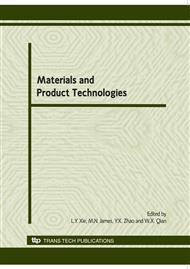[1]
D. N. P. Murthy, I. Djamaludin. New product warranty: a literature review [J]. inter-national journal of production economics, 2002; 79: 231-260.
DOI: 10.1016/s0925-5273(02)00153-6
Google Scholar
[2]
Jung GM, Lee JH, Park DH. Periodic preventive maintenance policies following the expiration of warranty. Asia-Pac journal of operation research, 2000; 17: 17-26.
Google Scholar
[3]
Jung GM, Park DH. Optimal maintenance policies during the post warranty period. Reliability Engineering and System Safety 2003; 82: 173-85.
DOI: 10.1016/s0951-8320(03)00144-3
Google Scholar
[4]
Gopinath Chattopadhyay, Anisur Rahman. Development of lifetime warranty policies and models for estimating costs [J]. Reliability Engineering and System Safety 2008; 93: 522-529.
DOI: 10.1016/j.ress.2007.02.005
Google Scholar
[5]
Ki Mun Jung, Sung Sil Han, Dong Ho Park. Optimization of cost and downtime for replacement model following the expiration of warranty [J]. Reliability Engineering and System Safety 2008; 93: 995-1003.
DOI: 10.1016/j.ress.2007.05.005
Google Scholar
[6]
N. Jack, B. P. Iskandar, D. N. P. Murthy. A repair-replace strategy based on usage rate for items sold with a two-dimensional warranty [J]. Reliability Engineering and System Safety 2009; 94: 611-617.
DOI: 10.1016/j.ress.2008.06.019
Google Scholar
[7]
Ruey Huei Yeh, Ming-Yuh Chen, Chen-Yi Lin. Optimal periodic replacement policy for repairable products under free-repair warranty[J]. European Journal of Operation Research 2007; 176: 1678-1686.
DOI: 10.1016/j.ejor.2005.10.047
Google Scholar
[8]
Yu-Hung Chien. Optimal age for preventive replacement under a combined fully renewable free replacement with a pro rata warranty, international Journal of Production Economics, doi: 10. 1016/j. ijpe. 2009. 10. 025.
DOI: 10.1016/j.ijpe.2009.10.025
Google Scholar
[9]
Shey-Huei Sheu, William S. Griffith, Toshio Nakagawa. Extended optimal replacement model with random minimal repair costs [J]. European Journal of Operational Research, 1995; 85: 636-649.
DOI: 10.1016/0377-2217(93)e0364-4
Google Scholar
[10]
Yu-Hung Chien. A general age-replacement model with minimal repair under renewing free-replacement warranty [J]. European Journal of Operational Research, 2008; 186: 1046-1058.
DOI: 10.1016/j.ejor.2007.02.030
Google Scholar
[11]
Barlow R, Hunter L. Optimum preventive maintenance policies[j]. European Journal of Operational Research. 1960 (8); 90-100.
Google Scholar
[12]
Y. L Lin. Stochastic process [M]. Beijing, Tsinghua University Press, (2002).
Google Scholar
[13]
L. Y Xie, X. H He, Jia Li. Reliability and safety design of mechanical and electronical systems.
Google Scholar


